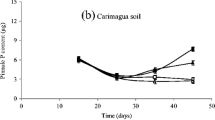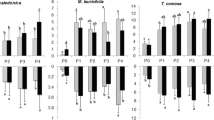Abstract
A total of 36 fungal species isolated from soil were tested for their ability to solubilize rock phosphate (RP) in agar plates. Most of these fungi were non-rock phosphate solubilizers, but two isolates, Aspergillus niger and Penicillium citrinum, had high activity. Liquid culture experiments revealed that both fungi caused a remarkable drop in pH of culture media and solubilized considerable amounts of phosphate. The effects on wheat of inoculation with vesicular–arbuscular mycorrhizal fungi and rock-phosphate-solubilizing fungi and fertilization with rock phosphate were studied in sterilized pot soils, nonsterilized pot trials and in field plot soils. Rock phosphate fertilization and inoculation with Glomus constrictum and rock-phosphate-solubilizing fungi (A. niger and P. citrinum) significantly increased dry matter yield of wheat plants under all experimental conditions. However, the effect was more evident in non- sterilized pot soils and in the field than in sterilized pots. Rock phosphate had no significant effect on the total phosphorus content of plants grown under pot conditions but it was significantly increased in field plots; the effect of inoculation with fungi (G. constrictum, A. niger and P. citrinum) on plant phosphorus was closely related to this in dry matter production. The greatest positive effect on growth and phosphorus contents of wheat plants was recorded in the treatments that received rock phosphate and were inoculated with a mixed inoculum of the three microorganisms used, followed by dual inoculation treatments of G. constrictum plus either A. niger or P. citrinum.
Similar content being viewed by others
References
Agnihotri, V.P. 1970 Solubilization of insoluble phosphate by some fungi isolated from nursery beds. Canadian Journal of Microbiology 16, 877.
Asea, P.E.A., Kucey, R.M.N. & Stewart, J.W.B. 1988 Inorganic phosphate solubilization by two Penicillium species in solution culture and in soil. Soil Biology & Biochemistry 20, 459–464.
Atlas, R.M., Pamer, D. & Bartha, R. 1978 Assessment of pesticide effects of non-target microorganisms. Soil Biology & Biochemistry 10, 231–239.
Bardiya, M.C. & Gaur, A.C. 1974 Isolation and screening of microorganisms dissolving low-grade rock phosphate. Folia Microbiologica 19, 386–389.
Barea, J.M., Azcon, R. & Hayman, D.S. 1975 Possible synergistic interactions between Endogone and phosphate-solubilizing bacteria in low-phosphate soil. In Endomycorrhiza, eds Mosse, B. & Tinker, P.T. London: Academic Press.
Beever, R.E. & Burns, D.J.W. 1981 Phosphate uptake, storage and utilization by fungi. Advances in Botanical Research 8, 127–219.
Chhonkar, P.A. & Subba Rao, N.S. 1967 Phosphate solubilization by fungi associated with legume root nodules. Canadian Journal of Microbiology 13, 749.
Cooke, G.W. 1956 The value of rock phosphate for direct application. Empire Journal of Experimental Agriculture 24, 295–306.
Cunningham, J.E. & Kuiack, C. 1992 Production of citric and oxalic acids and solubilization of calcium phosphate by Penicillium bilaii. Applied and Environmental Microbiology 58, 1451–1458.
Evans, D.G. & Miller, M.H. 1990 The role of the external mycelial network in the effect of soil disturbance upon vesiculararbuscular mycorrhizal colonization of maize. New Phytologist 114, 65–71.
Gaur, A.C. & Ostwall, K.P. 1972 Influence of phosphate dissolving bacilli on yield and phosphate uptake of wheat crop. Indian Journal of Experimental Biology 10, 393–394.
Gerdemann, J.W. & Nicolson, T.H. 1963 Spores of mycorrhizal Endogone species extracted from soil by wet sieving and decanting. Transactions of the British Mycological Society 46, 235–244.
Hall, I.R. & Fish, B.J. 1979 A key to the Endogonaceae. Transactions of the British Mycological Society 73, 261–270.
Hoagland, D.R. & Arnon, D.I. 1938 The Water-culture Method for Growing Plants Without soil, Circular 347, Berkeley: University of California Agricultural Experimental Station.
Islam, R., Ayanaba, A. & Sanders, F.E. 1980 Response of cowpea (Vigna unguiculata) to inoculation with VA-mycorrhizal fungi and to rock phosphate fertilization in some unsterilized Nigerian soils. Plant and Soil 54, 107–117.
Jackson, M.L. 1958 Soil Chemical Analysis. London: Prentice-Hall International Incorporation.
Johnson, L.F., Curl, E.A., Bend, J.H. & Friburg, H.A. 1959 Methods for Studying Soil Microflora-Plant Disease-Relationships. Minneapolis: Burgess Publishing Company.
Kucey, R.M.N. 1987 Increased phosphorus uptake by wheat and field beans inoculated with a phosphorus-solubilizing Penicillium bilaii strain and vesicular-arbuscular mycorrhizal fungi. Applied and Environmental Microbiology 53, 2699–2703.
Molla, M.A.Z. & Chowdhury, A.A. 1984 Microbial mineralization of organic phosphate in soil. Plant and Soil 78, 393–399.
Omar, S.A. 1995 Growth effects of the vesicular-arbuscular mycorrhizal fungus Glomus constrictum on maize plants in pot trials. Folia Microbiologica 40, 503–507.
Phillips, J.M. & Hayman, D.S. 1970 Improved procedures for clearing roots and staining parasitic and vesicular-arbuscular mycorrhizal fungi for rapid assessment of infection. Transactions of the British Mycological Society 55, 158–161.
Powell, C. Li. 1982 Selection of efficient VA mycorrhizal fungi. Plant and Soil 68, 3–9.
Rogers, H.T., Pearson, R.W., Ensminger, L.E. 1953 Comparative efficiency of various phosphate fertilizers. Agronomy 4, 189–242.
Ruiz-Lozano, J.M. & Azcon, R. 1993 Specificity and functional compatibility of VA mycorrhizal endophytes in association with Bradyrhizobium strains in Cicer arietinum. Symbiosis 15, 217–226.
Singal, R., Gupta, R. & Saxena, R.K. 1994 Rock phosphate solubilization under alkaline condition by Aspergillus japonicus and A. foetidus. Folia Microbiologica 39, 33–36.
Subba Rao, N.S. 1982 Phosphate solubilizing micro-organisms. In Biofertilizers in Agriculture, ed. Subba Rao, N.S., pp. 126–136. Oxford: Oxford and IBH Publication.
Swaby, R.J. & Sperber, J.I. 1958 Phosphate dissolving microorganisms in the rhizosphere of legumes. In Nutrition of the Legumes, p. 289. New York: Academic Press. [As cited in Bardiya, M.C. & Gaur, A.C. 1974 Folia Microbiologica 19, 386-389.]
Talukdar, N.C. & Germida, J.J. 1994 Growth and yield of lentil and wheat inoculated with three Glomus isolates from Saskatchewan soils. Mycorrhiza 5, 145–152.
Trappe, J.M. 1982 Synoptic keys to the genera and species of zygomycetous mycorrhizal fungi. Phytopathology 72, 1102–1108.
Author information
Authors and Affiliations
Rights and permissions
About this article
Cite this article
Omar, S. The role of rock-phosphate-solubilizing fungi and vesicular–arbusular-mycorrhiza (VAM) in growth of wheat plants fertilized with rock phosphate. World Journal of Microbiology and Biotechnology 14, 211–218 (1997). https://doi.org/10.1023/A:1008830129262
Issue Date:
DOI: https://doi.org/10.1023/A:1008830129262




